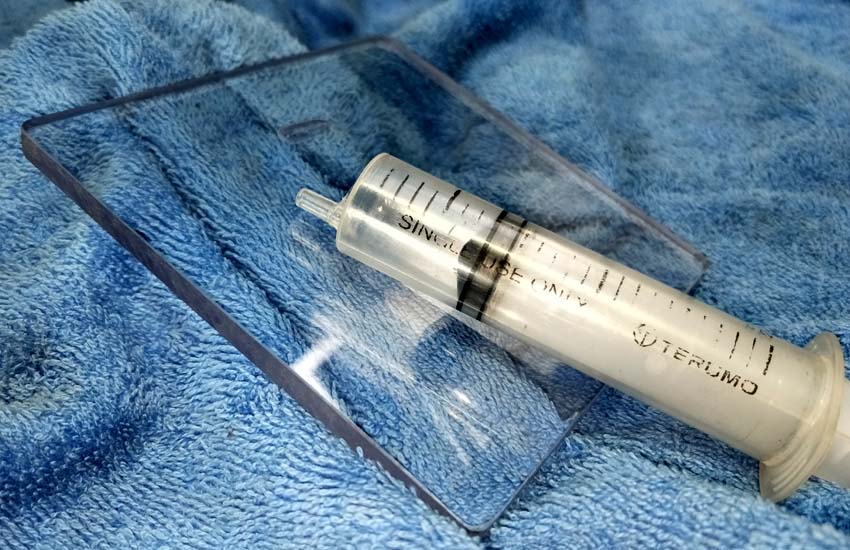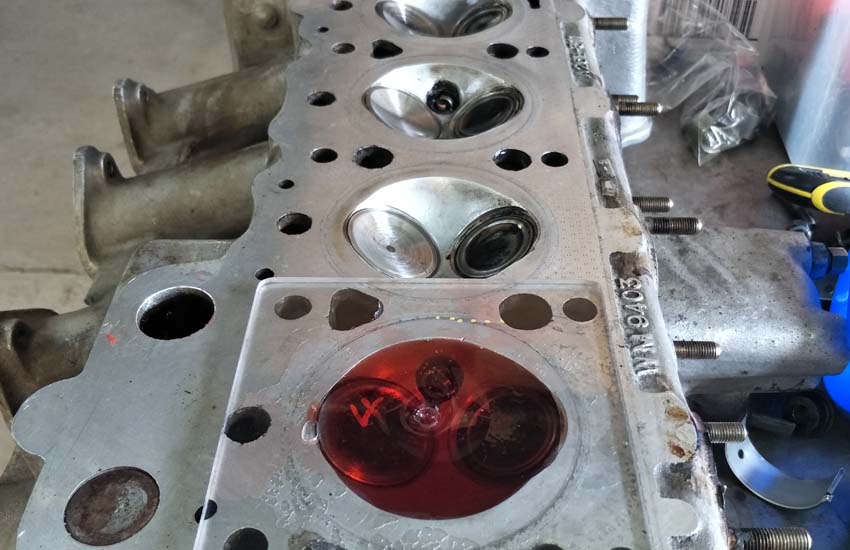CCeeing The Twin Cam Lotus Cylinder Head Chambers.
You’ve probably watched the guru video’s and experts doing this, and now you are led to believe that the process is a bit on the technical side, and requires some expensive scientific instruments?
Would that be correct or not?
Of course the first thing you’ll need is a TC cylinder head to work with, so why not your own, if you are at the rebuilding the engine stage.
The next thing you’ll need is some liquid, plus a couple of very simple tools, plus a very steady hand, don’t attempt this if you’ve been on the turps. Oh, and of course, you’ll also need a good old fashioned pen and piece of paper to write down the results of your experiment… just like the real scientists do. 
Cheap CC Tools – Clear Acrylic Cover Plate and 25cc Syringe. (The clear plate has a small hole drilled in the centre)
OK, I hope the photo above doesn’t look too much like a what a junkie might take. But this is the total of the really simple tools required to CC the combustion chamber of the twin cam lotus head.
So what type of liquid? Just about anything, but we found in a tin sitting on the shelf, some old ATF fluid, it is a nice red colour, and is very easy to see, and depending on the temperature, it has a good viscosity in the warm Aussie climate… but that could be different to where you live, and if its too thick, dilute it down with kero or something else.
The clear acrylic plate happens to be a square cut out of a scrap bit of poly carbonate… very tough, and very nice. Simply drill a hole in the centre to poke the nozzle of the syringe through to fill the chamber.
A simple tool for the filling job is a graduated 25cc capacity syringe, the syringe in the photo was found amongst the bulk ink refill kit for my inkjet printer, works like a charm, has graduations, and is easy to use.
Take note when filling the syringe exactly how much fluid is actually in the syringe, write down the amount, you wont get it in one go.  Twin cam cylinder head – Clear plate and ATF.
Twin cam cylinder head – Clear plate and ATF.
The clear acrylic plate above is barely visible in the photo. To make a seal between the plate and the head, smear a thin layer of petroleum jelly around the chamber of the head, then press the clear plate down gently with your hand to make an effective seal.
Like wise, to seal the valves onto the seats, (There is NO need for valve springs for this exercise) place a thick layer of general grease around each valve and insert it into the guide, and press each valve home onto the seat, then wipe the excess grease away with a rag.
Before the job begins, don’t forget to screw the spark plugs into the head, and don’t be concerned about the void in the plug, it is that small, you really don’t have to worry about it…. Not for a road tune engine anyway.
 Liquid filled combustion chamber = 35cc neat.
Liquid filled combustion chamber = 35cc neat.
So that’s it. To continue to CC the remaining combustion chambers, simply rinse and repeat the process. Writing down what the capacity is for each chamber, hopefully, they will be all equal.
When filling the very last small voids under the clear plate, an air bubble will probably occur, a simple method to get rid of the bubble is to tilt the head slightly without upsetting the levelling of the head, the bubble will find the central hole and be dispersed to the atmosphere… some very light taps on top of the clear plate will also help, but most importantly…
Take note of how much you are dispensing with the syringe, you need to watch what you are doing more carefully than if a burette is being used.
It is important to know what the volume of each combustion chamber is when rebuilding the engine, as it enables (Along with other measurements) the ability to calculate what the given compression ratio is, and if there is a requirement or not, to increase, or decrease the ratio sum so that it matches the chosen stage of engine tune.
For your information, the above twink cyl head measured exactly 35CCs for each chamber. A good result.
In Summary. Like many other people, the first thoughts were to buy a special burette – Costing from $50 to $100. And after use it would be placed in the workshop draw, and probably never used again.
Just one other important thing to understand. When setting up the cylinder head for this project, it must be dead level lengthwise, as well as sideways… you MUST spend the time to get the head perfectly level, otherwise it is a waste of time going through the motions.
Good Luck with your Project.
elantrikbits Australia Sharing Knowledge With Other Lotus Elan Owners.
You might like to know what cost of this CCing exercise was?
Time only – The tools and materials were found items – Actual Cost to CC twin Cam Head – $00.00.
Just one other important thing to understand. When setting up the cylinder head for this project, it must be dead level lengthwise, as well as sideways… you MUST spend the time to get the head perfectly level, otherwise it is a waste of time going through the motions.
Good Luck with your Project.
elantrikbits Australia Sharing Knowledge With Other Lotus Elan Owners.
Leave a Reply
You must be logged in to post a comment.